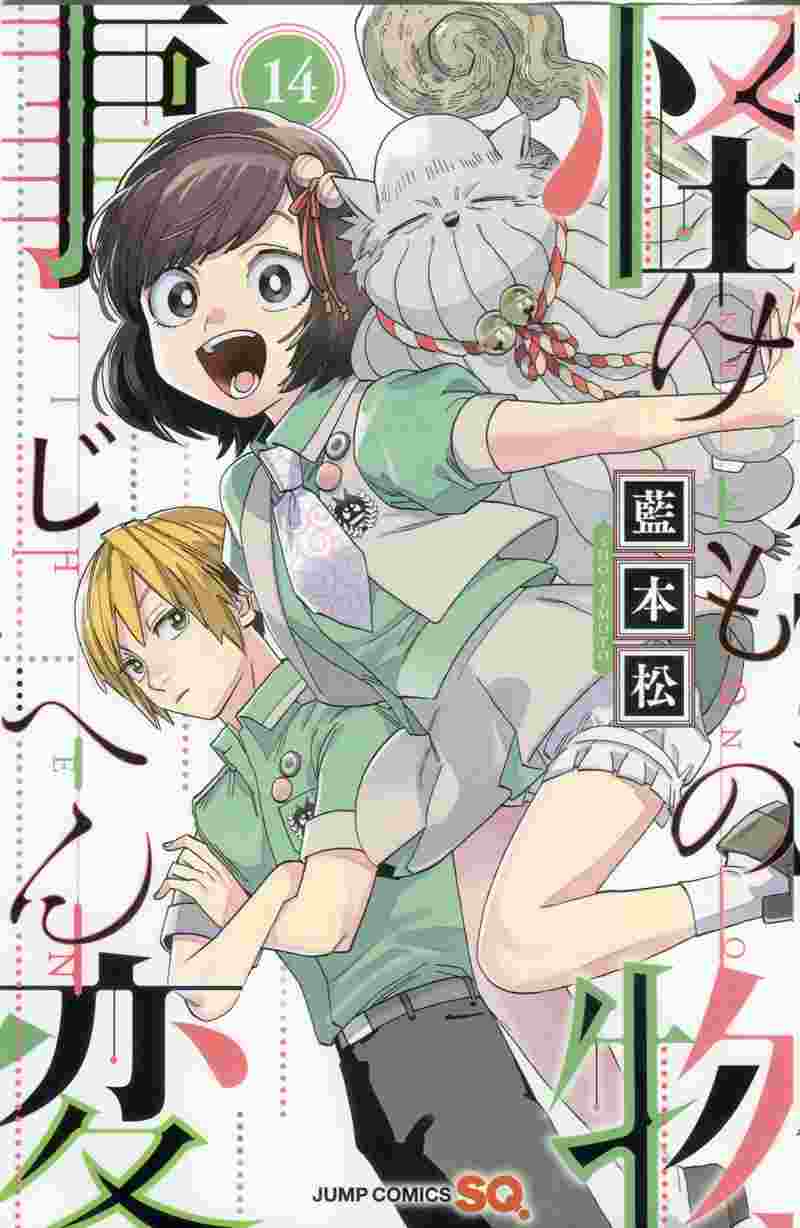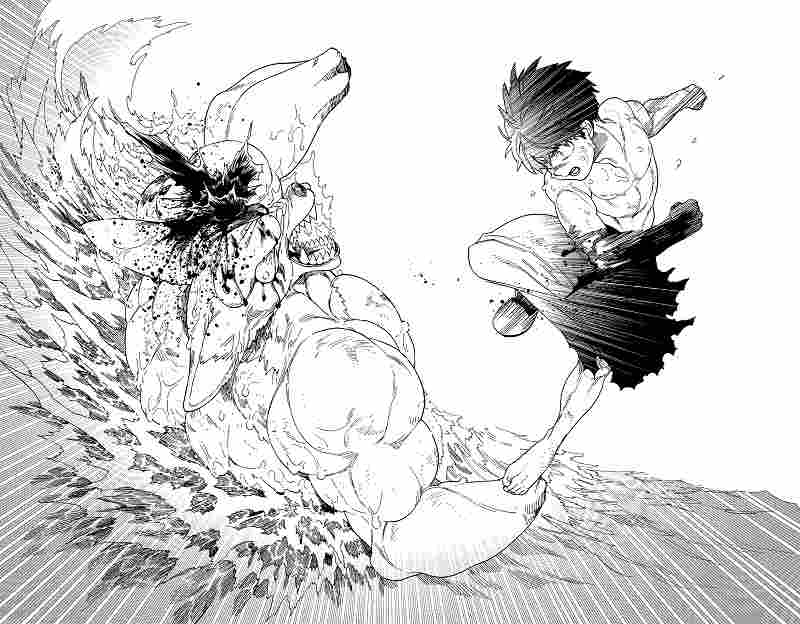
The cover art of the 14th volume of “Kemono Jihen”
10:30 JST, September 24, 2021
In the world of manga “Kemono Jihen,” the events depicted in Japanese ghost and horror stories passed down from eons ago were actually acts committed by “kemono,” or otherworldly beings with supernatural powers, who secretly live among us. Protagonist Kabane, a boy born between a human and a kemono, matures through his encounters with other kemono and the battle over stones with the hidden power to control humans.
The manga is currently serialized in Shueisha Inc.’s Jump Square manga magazine.
When written phonetically, kemono is a Japanese word for “beast,” but the kanji applied to the word in this manga is more akin to “monster.” According to the mangaka Sho Aimoto, kemono are closer to animals or beasts than yokai — monsters and supernatural beings in Japanese folklore.
The story unfolds in today’s Japan, where humans no longer perceive the presence of kemono. Aimoto said the idea for the series sprang from Japanese mythology and stories of yokai.
“I thought that myths were the result of people trying to convince themselves of things beyond their imagination, like natural disasters, by likening them to divine beings,” she said. “Then, I thought it would be interesting if kemono were seen by people in such a way.”
Kabane, 13, is a hybrid of a human and a ghoul called a “khoular,” which renders him immortal. Without his parents around, he grows up deprived of proper education and upbringing. In the beginning, he lacks common sense and shows little emotion. Aimoto describes him as “an empty vessel.” That, however, begins to change once he starts working at a company dedicated to solving various problems involving other kemono passing as humans. Among his coworkers are Inugami, a supernatural tanuki raccoon dog; Shiki, a human-arachne spider monster hybrid; and Akira, a yukionoko (snow boy). Little by little, Kabane begins to express his emotions.
To find clues about his parents, he sets out to collect the stones infused with kemono power and becomes involved in the fight against the demonic fox Inari and her subordinates, who aim to control humans using the power of the stones.
“I’ve given Kabane challenges to explore how I can evoke emotions in him and how I should have him overcome those difficulties, which I imagined as putting many things into his [empty] vessel,” Aimoto said. “I’m considering making this a story in which ultimately something is acquired, rather than being about loss.”
When reading this manga, the most appealing aspects are the dynamic battle scenes and the character development of pure and innocent Kabane and his castmates. Another major theme runs beneath the plot’s surface; one that is relevant to contemporary society.
“It’s coexistence,” Aimoto said.
The manga features not only tanuki and fox kemono, but other kemono species such as cats, mosquitoes, frogs, constrictors, kappa water imps and vampires. They can either fight each other or work together.
Various subplots unfold amid the battles, such as a love story between a human and a nekomata feline kemono and an episode about a fox kemono who tries to create a world where her boyfriend, a serial and psychotic murderer, finds it easier to live. Aimoto has also included satire regarding human society in depicting a human who repeatedly experiments with kemono interbreeding, and a factory that processes humans into food.
“Breeding animals, improving breeds or protecting endangered species — those are all done at the convenience of humans, I think,” the mangaka said. “I think it probably stands to reason that some superior being would come along and makes humans their food.”

Kabane, right, fights against a fox kemono in “Kemono Jihen”
“[Thoughts on] why a certain problem has occurred have piled up and I might have subconsciously interwoven them into some parts of the story,” she said. “I’m interested in diversity as well. In modern society, the idea of acknowledging people who are different from yourself has become widespread, even though there are also those who cannot accept things that are beyond their understanding. I also want to consider this issue through this work.”
Aimoto debuted as a mangaka at 18, just after graduating from high school. She is particularly known for “Hokenshitsu no Shinigami” (The infirmary’s death god), which was serialized in the Shukan Shonen Jump weekly manga magazine.
“Kemono Jihen” began serialization in 2016, and a TV anime adaptation first aired in January, adding fire to its growing popularity. Although the story has up until now mainly revolved around kemono, human characters will become more relevant from now on, according to the author.
“It makes me happy when someone tells me that reading [my] manga empowers them even if they’re going though painful times,” she said. “I hope readers will feel excited that the immortal protagonist will come and help them.”
"Culture" POPULAR ARTICLE
-

Van Cleef & Arpels Dazzles with Art Deco Artisanry at Tokyo Exhibit
-

Disney’s ‘Twisted-Wonderland’ Animated Series Puts Villains in Spotlight: New Show Features School Inspired by Classic Disney Films
-

Ayumi Hamasaki’s Shanghai Concert Canceled Day Before Schedule as Part of Beijing Backlash
-

‘The World Masterpiece Theater Series’ Celebrates 50 Years; Animator Looks Back on Creating Anime Classics
-

Popularity of Piggy Banks Across Time and Place Seen at Bank’s Museum of Money Boxes in Hyogo Pref.
JN ACCESS RANKING
-

Tokyo Economic Security Forum to Hold Inaugural Meeting Amid Tense Global Environment
-

Keidanren Chairman Yoshinobu Tsutsui Visits Kashiwazaki-Kariwa Nuclear Power Plant; Inspects New Emergency Safety System
-

Imports of Rare Earths from China Facing Delays, May Be Caused by Deterioration of Japan-China Relations
-

University of Tokyo Professor Discusses Japanese Economic Security in Interview Ahead of Forum
-

Japan Pulls out of Vietnam Nuclear Project, Complicating Hanoi’s Power Plans



◎上海の日本アニメイベント_20251129YGTGS000921_C-250x168.jpg)


















